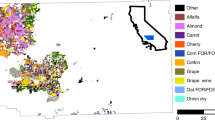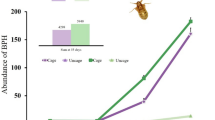Abstract
An important part of landscape ecology is determining how the arrangement (aggregation or fragmentation) of patches in space influences the population dynamics of foraging organisms. One hypothesis in agricultural ecology is that fine-grain spatial heterogeneity in cropping (many small agricultural fields) should provide better pest control than coarse-grain heterogeneity (few large agricultural fields); this hypothesis has been proposed as an explanation for the increased pest abundance associated with agricultural intensification. However, empirical studies have found mixed support for this hypothesis, and some, surprisingly, demonstrate a strong decrease in pest abundance with increased crop aggregation. We developed a spatially explicit simulation model of pest movement across an agricultural landscape to uncover basic processes that could reduce pest abundance in landscapes with fewer, larger fields. This model focuses on herbivore movement and does not include predation effects or other biological interactions. We found that field aggregation in the model led to severely reduced pest densities and further discovered that this relationship was due to an increased distance between fields and a decreased “target area” in more aggregated landscapes. The features that create a negative relationship between aggregation and pest densities rely on crop rotation and limited dispersal capabilities of the pests. These findings help to explain seemingly counter-intuitive empirical studies and provide an expectation for when field aggregation may reduce pest populations in agro-ecosystems.





Similar content being viewed by others
References
Altieri MA (2002) Agroecology: the science of natural resource management for poor farmers in marginal environments. Agric Ecosyst Environ 93:1–24. https://doi.org/10.1016/S0167-8809(02)00085-3
Altieri MA, Letourneau DK (1982) Vegetation management and biological control in agroecosystems. Crop Prot 1(4):405–430. https://doi.org/10.1016/0261-2194(82)90023-0
Bender DJ, Contreras TA, Fahrig L (1998) Habitat loss and population decline: a meta-analysis of the patch size effect. Ecology 79:517–533. https://doi.org/10.2307/176950
Bianchi FJJA, Booij CJH, Tscharntke T (2006) Sustainable pest regulation in agricultural landscapes: a review on landscape composition, biodiversity and natural pest control. Proc Biol Sci 273:1715–1727. https://doi.org/10.1098/rspb.2006.3530
Bommarco R, Banks JE (2003) Scale as modifier in vegetation diversity experiments: effects on herbivores and predators. Oikos 102:440–448. https://doi.org/10.1034/j.1600-0579.2003.12578.x
Bowers MA, Matter SF (1997) Landscape ecology of mammals: relationships between density and patch size. J Mammal 78:999–1013. https://doi.org/10.2307/1383044
Bowman J, Cappuccino N, Fahrig L (2002) Patch size and population density: the effect of immigration behavior. Conserv Ecol 6(1):9. https://doi.org/10.5751/es-00354-060109
Chavez A (1997) Actividad Migratoria y Daño del Gorgojo (Premnotrypes spp.) en dos Comunidades del Departamento de La Paz. [B.S.]. Universidad Tecnica de Oruro, Oruro
Debinski DM, Holt RD (2000) A survey and overview of habitat fragmentation experiments. Conserv Biol 14:342–355. https://doi.org/10.1046/j.1523-1739.2000.98081.x
Englund G, Hambäck PA (2007) Scale dependence of immigration rates: models, metrics and data. J Anim Ecol 76:30–35. https://doi.org/10.1111/j.1365-2656.2006.01174.x
Hambäck PA, Englund G (2005) Patch area, population density and the scaling of migration rates: the resource concentration hypothesis revisited. Ecol Lett 8:1057–1065. https://doi.org/10.1111/j.1461-0248.2005.00811.x
Ioannou CC, Bartumeus F, Krause J, Ruxton GD (2011) Unified effects of aggregation reveal larger prey groups take longer to find. Proc R Soc B 278:2985–2990. https://doi.org/10.1098/rspb.2011.0003
Kaya H, Alcazar J, Parsa S, Kroschel J (2009) Microbial control of the Andean potato weevil complex. Fruit Veg Cereal Sci Biotech 3(1):39–45. https://doi.org/10.1016/j.biocontrol.2006.04.003
Parsa S (2010) Native herbivore becomes a key pest after dismantlement of a traditional farming system. Am Entomol 56(4):242–251. https://doi.org/10.1093/ae/56.4.242
Parsa S, Ccanto R, Rosenheim JA (2011) Resource concentration dilutes a key pest in indigenous potato agriculture. Ecol Appl 21:539–546. https://doi.org/10.1890/10-0393.1
Poveda K, Gomez MI, Martinez E (2008) Diversification practices: their effect on pest regulation and production. Rev Colomb Entomolgia 34:131–144
Root RB (1973) Organization of a plant-arthropod association in simple and diverse habitats: the fauna of collards (Brassica oleracea). Ecol Monogr 43:95–124. https://doi.org/10.2307/1942161
Segoli M, Rosenheim JA (2012) Should increasing the field size of monocultural crops be expected to exacerbate pest damage? Agric Ecosyst Environ 150:38–44. https://doi.org/10.1016/j.agee.2012.01.010
Vinatier F, Lescourret F, Duyck PF, Tixier F (2012) From IBM to IPM: using individual-based models to design the spatial arrangement of traps and crops in integrated pest management strategies. Agric Ecosyst Environ 146(1):52–59. https://doi.org/10.1016/j.agee.2011.10.005
White JW, Rassweiler A, Samhouri JF, Stier AC, White C (2014) Ecologists should not use statistical significance tests to interpret simulation model results. Oikos 123:385–388. https://doi.org/10.1111/j.1600-0706.2013.01073.x
Acknowledgements
We thank Soroush Parsa for guidance on the biology of the potato weevil system and Stephen Ellner, Anurag Agrawal, and their respective labs for comments on the manuscript. Two anonymous reviewers provided comments that greatly improved this manuscript.
Funding
This study was supported by a grant from the US Department of Agriculture (RAMP grant ARZT-358320-G-30-505) and a National Science Foundation Graduate Research Fellowship Program (NSF GRFP grant DGE-1144153) to C.B.E.
Author information
Authors and Affiliations
Rights and permissions
About this article
Cite this article
Edwards, C.B., Rosenheim, J.A. & Segoli, M. Aggregating fields of annual crops to form larger-scale monocultures can suppress dispersal-limited herbivores. Theor Ecol 11, 321–331 (2018). https://doi.org/10.1007/s12080-018-0369-0
Received:
Accepted:
Published:
Issue Date:
DOI: https://doi.org/10.1007/s12080-018-0369-0




